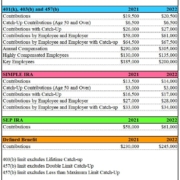Retirement Plan Contribution Limits for 2024 and 2023 – 01/01/24
Money Matters – Skloff Financial Group Question of the Month – January 1, 2024
By Aaron Skloff, AIF, CFA, MBA
Q: We are ready to get serious about our retirement savings in 2024. What are the contribution limits for various retirement accounts in 2024?
The Problem – Lack of Retirement Savings
Most pre-retirees recognize they lack an adequate level of savings to enjoy a financially sound retirement. Even as public programs like Social Security and Medicare crumble, many pre-retirees are still hoping these programs will provide them an adequate means of retirement benefits. If these programs remain in existence over the next 20-30 years, they will likely provide a shrinking percentage of retirees’ needs. Responsible savers looking to build their savings to pay for their retirement expenses and/or leave a tax advantaged legacy face a big problem. The government places strict annual contribution limits on tax advantaged retirement savings vehicles.
The Solution – Take Advantage of Tax Advantaged Savings Vehicles
If you have an inadequate level of retirement savings now is the time to begin closing the gap between what you have and what you need. Ideally, utilize tax advantaged savings vehicles that provide a combination of immediate tax benefits and/or tax benefits for decades to come for you and your beneficiaries. Let’s look at some of the most common ones below.
Traditional and Roth 401(k), 403(b) and 457(b) Retirement Accounts
These are employer sponsored retirement accounts with generous employee contribution limits. Generally, you can contribute up to $23,000 (up from $22,500 in 2023) per year if you are less than 50 years old or up to $30,500 (up from $30,000 in 2023) if you are 50 years old or older. You may also contribute up to $46,000 on an after tax basis if your plan permits it (not available on 457(b)). Additionally, many employers match contributions and/or provide profit sharing contributions. The maximum contribution amount you and your employer (combined) can make per year is $69,000 (up from $66,000 in 2023) if you are less than 50 years old or $76,500 (up from $73,500 in 2023) if you are 50 years old or older. The combined contributions are based on $345,000 (up from $330,000 in 2023) maximum considered compensation. The traditional 401(k), 403(b) and 457(b) provide an immediate tax benefit and a deferral of income taxes, while the Roth versions forego the immediate tax benefit and provide tax free withdrawals. The IRS allows you to contribute to multiple employer retirement plans.
Simplified Employee Pension Plan Accounts (SEPs)
SEPs are employer sponsored retirement plans with very generous employer contribution limits. Generally, employers can contribute up to 25% of an employee’s compensation. The maximum contribution an employer can make is $69,000 (up from $66,000 in 2023), based on $345,000 (up from $330,000 in 2023) maximum considered compensation.
Savings Incentive Match PLan for Employees (SIMPLE) IRA Accounts
SIMPLE plan accounts are employer sponsored retirement plans with generous employee contribution limits. Generally, you can contribute up to $16,000 (up from $15,500 in 2023) per year if you are less than 50 years old or up to $19,500 (up from $19,000 in 2023) if you are 50 years old or older. Additionally, employers are required to make contributions to your account on an elective or nonelective basis. The maximum elective match is 3% of compensation, not to exceed $16,000 (up from $15,500 in 2023) if you are less than 50 years old or up to $19,500 (up from $19,000 in 2023) if you are 50 years old or older. The nonelective contribution is 2% of compensation based on $345,000 (up from $330,000 in 2023) maximum considered compensation – resulting in a $6,900 (up from $6,600 in 2023) limit.
Traditional and Roth Individual Retirement Accounts (IRAs)
In lieu of or in addition to employer sponsored retirement plans, you can contribute to an IRA. You can contribute up to $7,000 (up from $6,500 in 2023) per year if you are less than 50 years old or up to $8,000 (up from $7,500 in 2023) if you are 50 years old or older. The Traditional IRA provides pre-tax or post tax contributions (based on your income and employer sponsored retirement plan status) and tax deferral. The traditional IRA provides an immediate tax benefit and a deferral of income taxes, while the Roth version foregoes the immediate tax benefit and provides tax free withdrawals.
Action Steps
Boost your retirement savings with tax advantaged savings vehicles and gain tax benefits as you close your retirement savings gap. Don’t put off until tomorrow what you can do today.
Aaron Skloff, Accredited Investment Fiduciary (AIF), Chartered Financial Analyst (CFA), Master of Business Administration (MBA) is CEO of Skloff Financial Group, a Registered Investment Advisory firm specializing in financial planning, investment management and benefits for small to middle sized companies. He can be contacted at www.skloff.com or 908-464-3060.












